Ferrari FF due locally early 2012
|
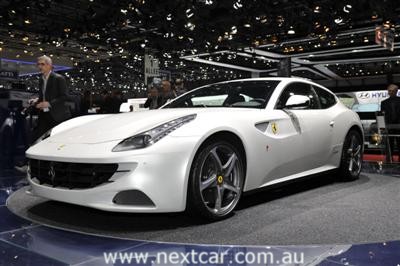
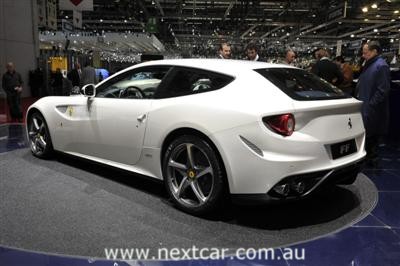 Ferrari FF at the 2011 Geneva Motor Show
Ferrari FF at the 2011 Geneva Motor Show
|
|
|
Home >
News >
Ferrari
Other stories:
Bentley
Continental GT Mulliner Styling Specification
26th June, 2011
Ferrari FF to appear soon
23rd January, 2011
26th June, 2011
One of the slowest manufacturers to introduce a
four-wheel drive model is Ferrari. However, with the early 2012 local release of the new FF, Ferrari
finally joins Audi, Bentley, Lamborghini, Nissan and others who offer super cars with all-wheel drive.
“This new Ferrari takes the prancing horse into new territory, matching the legendary performance,
style and driving excitement expected of a Ferrari with new levels of ability thanks to its unique
four-wheel drive system and its spacious and flexible interior which makes it the most useable and
versatile super car built by Ferrari,” says Kevin Wall, General Manager of European Automotive
Imports, the Ferrari importer in Australia and New Zealand.
The Ferrari FF is a four-seater that changes the whole GT sports car concept. Even the most casual
glance at the FF’s Pininfarina-penned profile will indicate that.
The Australian price of the Ferrari FF has also been confirmed ahead of the first deliveries to
Australia starting in early 2012 at $625,000* (MLP*). This is $73,000 (before on-road costs) lower than
the out-going Ferrari 612.
Drive it - anywhere, any time, in any weather or road conditions – and you’ll know why it’s so radical.
It may be a car that has elegance, beauty and art in its soul, but there’s much, much more to the FF than
sophisticated allure. It was, in fact, designed specifically to tackle the toughest, most complex and
ambitious of driving challenges. The kind of challenges that the most uncompromising and discerning drivers
will want to set it. Drivers that demand their cars give of their all. Effortlessly. Regardless of weather
or surface.
The FF: a name inspired by the car’s four generous, body-hugging seats and, more significantly, the new
Prancing Horse-patented four-wheel drive system. Purists will be overjoyed to know that it is still the
rear wheels that actually provide the power, with torque being transferred only to the front axle when
required and even then intelligently and predicatively distributed to all four wheels. Yet another reason
why this is the most versatile Ferrari ever built.
|
|
|
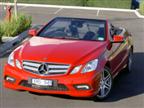
Mercedes-Benz E 350
road test
..... more
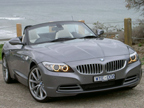
BMW Z4
road test
..... more
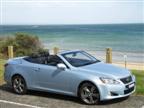
Lexus IS 250C
road test
..... more
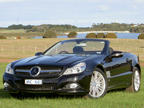
Mercedes-Benz SL 600
road test
..... more
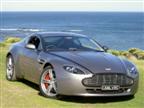
Aston Martin V8 Vantage
road test
..... more
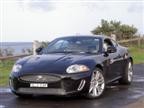
Jaguar XKR
road test
..... more
|
|
|
But take note: the FF is also one of the most exclusive GT on the market, the pinnacle of achievement
for Ferrari. It has it all according to Ferrari: exceptional performance that pushes its signature Ferrari
'DNA' and driving pleasure to the utmost, regardless of weather or terrain. Even on snow, ice and dirt.
The FF also sets a new benchmark in terms of sheer innovation: it is the first four-wheel drive V12 with
a rear-mounted electronic differential, the E-Diff.
The Ferrari-patented four-wheel drive system is unique and also integrated with the new generation
F1-Trac traction control developed specifically for the track. The FF is also the first and only V12 in the
world to sport the seven-speed dual-clutch F1 gearbox with 20% more power output and 25% lower fuel
consumption. It offers four occupants superb in-car comfort with wraparound seats and unprecedented cabin
and luggage space for a car in its category.
The FF’s architecture too ticks all the boxes with authentic sports car driving dynamics, braking and
suspensions. It also boasts Ferrari's best weight-power ratio ever achieved, thanks in part to the fact
that its patented four-wheel drive system is just 50% the weight of a traditional version. Style-wise, the
FF is sculptural yet streamlined: it has an shooting brake shape, modern styling cues, and third millennium
aerodynamic and conceptual solutions to underscore its sporty stance. It is also unique on several levels:
for instance, the paints used for its livery were specifically designed for it and the leathers that adorn
its interiors have been given a treatment to enhance their natural beauty.
The FF is tailored to perfection to suit the exclusive style of its owner. It’s as much a car for
day-to-day driving as it is for extraordinarily unique occasions.
A car you can drive alone or share on a road trip with three other occupants. A car to take it easy
in or really push to the limits.
The engine
Make no mistake about it: it brings a wealth of technology to the mix, starting with a completely new
mid-front-mounted 6,262 cc GDI V12 that delivers unprecedented performance and responsiveness at all
engine speeds: 660 CV at 8,000 rpm, a specific output of 105 CV/l (77 kW/ cu in), a weight-power ratio of
2.7 Kg/CV. The torque is also blistering: 683 Nm at 6, 000 rpm, 500 Nm available from 1,000 rpm up to 8,000
rpm (virtually across the entire range).
To top it off, the FF has a top speed of 335 Km/h and sprints from 0 to 100 km/h in just 3.7 seconds.
The impressive figures are the result of a host of technical solutions which include high pressure GDI
(200 bar) and "Split Injection Control" that guarantee perfect fuel pulverisation and an optimal air-fuel
mix up to 8,000 rpm. The FF also has the highest compression ratio (12.3:1) in its segment and a valve
system that counteracts drops in pressure and losses due to windage caused by the pumping action of the
pistons. Leading-edge materials have been adopted for the pistons, seals and camshaft to minimise friction.
The FF has a combustion control system that uses ionisation currents – this boosts the engine’s power
output whilst reducing both fuel consumption and CO2 emissions to levels previously unheard of in a car
with these characteristics.
This impressive result is attributable to a whole series of factors affecting every area of the car. They
include the introduction of the HELE (High Emotions-Low Emissions) and the Stop&Start Systems (which cuts
out the engine during short stops and then restarts it), optimised braking, intelligent engine fan control,
constant fuel pump capacity control, and electronic air-conditioning compressor displacement control. All of
these solutions combine to cut fuel consumption to a claimed 15.4 litres per 100 km and CO2 emissions to 360
g/km, a 25% reduction on the previous Ferrari V12s.
The engine’s geometries and materials were also developed to harmonise intake and exhaust sounds to
underscore the car’s sporty character without impinging on acoustic comfort. To the ears of the driver and
passengers, the Ferrari FF’s engine sound is clear and powerful because the intake noise is channelled from
the filter casings into the cabin. The Ferrari 'orchestra' playing in this V12 never misses a note
regardless of speed or conditions. It is also designed to ensure that anyone that hears an FF go by will
instantly recognise its unmistakable Ferrari soundtrack without experiencing the slightest discomfort. This
isn’t noise: it’s music to the ears.
Transmission and vehicle dynamics
The FF delivers exhilarating driving pleasure as it effortlessly copes with low grip surfaces, handles
beautifully in all kinds of conditions, and delivers high-performance starts from standstill even on the
slipperiest, snowiest and iciest of surfaces. The coupling of its powerful V12 with the Ferrari F1
seven-speed dual clutch gearbox make it a joy to drive.
Owners will be able to experience its power and sophistication on all kinds of terrain and conditions
too, courtesy of Ferrari’s patented new lightweight 4RM (four-wheel drive).
The F1 dual clutch gearbox combines the unadulterated driving pleasure of a sequential gearbox with
the comfort of an automatic one. Gear-shifting times have been cut to zero and the acceleration gap
typically experienced with manual and electrohydraulic gearboxes has been completely eliminated. The
E-Diff is now integrated into the gearbox casing itself, a solution that has helped reduce the car’s
overall weight. Ferrari’s first ever four-wheel drive system actually shares a CPU with the E-Diff and
F1-Trac. This fact, combined with instantaneous grip estimation on any kind of surface, guarantees perfect
driveability and handling even when conditions are so poor that the rear-wheel drive can no longer send
enough power to the road. This is the kind of situation drivers typically find themselves faced with on
extremely slippery icy or snow-covered surfaces.
4RM System
The 4RM is an entirely new system that transmits torque to all four wheels of the car. A Ferrari patent,
it is the main innovation sported by the new FF. Unlike a conventional four-wheel drive system fitted to a
front-engined car, it allows the retention of the traditional mid-front engine architecture, with rear
transaxle connected to the engine by a single driveshaft. Added to this is the new Power Transfer Unit or
PTU for the front wheels, which is connected directly to the engine and located over the front axle.
This layout permits:
- A 50% saving in weight compared to a traditional four-wheel drive system. This greatly benefits the
FF’s weight-to-power ratio and thus its performance;
- A low centre of gravity to be maintained and the retention of Ferrari’s preferred weight distribution
with more than 50% of weight over the rear axle despite it being a front-engined car.
The PTU is the main mechanical component of the 4RM and manages the difference between the engine and
wheel speeds. It also controls the amount of torque sent to the front wheels in general and distributes it
between left and right as required. The PTU gets its power and torque directly from the crankshaft through
a system of gearbox ratios. Two independent carbon-fibre oil-bath wet multi-plate clutch packs then vector
the torque to a half shaft connected to the front wheels. Thus, there is no mechanical connection between
rear and front axles as they are linked to two completely independent traction systems. This means the FF
can be rear-wheel drive-only so that none of the exhilarating driving pleasure associated with this kind of
car is lost.
Lastly, the multi-disc clutches also deal with the different speeds at which the front and rear wheels
rotate, and the front axle, fulfilling the function of the centre and front differentials in a traditional
4WD system.
Furthermore, the front clutches are completely independent and have torque vectoring functions to allow
different amounts of torque to be sent to the left and right wheels. The amount of torque transmitted is
controlled by closing the disc packs in the individual clutches.
The PTU is also very compact (barely 170 mm long) and extremely light with the result that the 4RM
weighs 50% less than a conventional 4WD system.
The hydraulic gear and clutch actuation system is integrated into the PTU, as with the F1 Dual Clutch
gearbox, and this delivers absolutely blistering gear-shifting times and thus improved system
responsiveness.
Dynamic Controls
Dynamic vehicle control is also managed first and foremost by the Evolved GT Manettino on the F1-derived
steering wheel. It has five settings: ESC OFF, which disables all traction and stability control systems;
SPORT, to enhance driving pleasure in high grip situations; COMFORT, for maximum stability and easy handling
in high grip situations; WET and ICE-SNOW, with electronic controls specifically calibrated for maximum
stability and ease of handling in low and very low grip conditions.
The Evolved GT Manettino also controls the SCM3, the third generation of the Ferrari Magnetorheological
Suspension System. The latter uses a fluid the viscosity of which is altered by an electronically-controlled
magnetic field generated inside the damper. Control software adjusts the intensity of the magnetic field
every millisecond. Thanks to the SCM3, damping is now five times faster than with conventional shock
absorbers. The FF also has ABS/EBD, the anti-lock braking system which intervenes individually on all four
wheels.
The ESC (Electronic Stability Control) also intervenes during braking on all four wheels independently.
The E-Diff, on the other hand, distributes torque to both of the rear wheels while the race-derived F1-Trac
traction control system intervenes on the rear axle. Lastly, the 4RM Control integrates the F1 Trac +
E-Diff + PTU control functions, and manages both traction and stability by distributing exactly the right
amount of torque to each of the four wheels, thanks to seamless integration of all the systems.
The predictive software logic that underpins the 4RM Control estimates grip. For the first time on the
FF, it covers all possible driving conditions from ice to dry track surfaces too. Grip estimation was first
used in motor racing and then developed for road cars. It also underpins the F1-Trac system and allows the
FF to instantly and accurately estimate the maximum amount of torque that each wheel can offload without
wheel spin occurring. What this means in practice is that 4RM Control always guarantees maximum traction
regardless of the road conditions, because it independently distributes the maximum amount of torque that
can be transmitted to each individual wheel.
The 4RM Control works on the principle that torque is only sent to the front axle when necessary i.e.
when the driver needs more torque than the rear axle can deliver in a given grip situation. When the driver
requires less torque than the maximum amount transferable by the rear wheels in a specific grip condition,
then traction is controlled by the F1-Trac but on the rear wheels only. The E-Diff then works to ensure the
optimal distribution of the torque to the rear wheels in the various situations that can arise, such as
limited slip of the differential coming out of bends (as already happens with the 458 Italia). When the
driver needs more torque than the rear axle can deliver, the extra torque is transferred by the 4RM Control
to the front axle via the PTU. The 4RM Control actually distributes the torque completely independently to
the front right and left wheels.
This means that there is only front-wheel drive when the FF’s weight distribution, and F1-Trac and E-Diff
controls alone aren’t enough to transfer the amount of torque required by the driver to the ground i.e. in
all low and very low grip conditions in which the driver still demands performance driving from the car.
The 4RM Control features multiple logics specifically developed for the various low and very low grip
conditions the FF may be faced with.
When accelerating out of bends in low grip conditions, the F1-Trac, E-Diff and PTU work together to
distribute maximum torque to each individual wheel to maintain performance. However, torque is transmitted
to the front wheels only in a balanced, progressive way to guarantee maximum stability.
The system can also recognise under- and oversteer situations and variations in grip. It instantly
corrects them by modifying the amount of torque transmitted to each wheel. Once again, this guarantees
maximum stability.
The 4RM Control also has a specific high performance start logic optimised for low and very low grip
surfaces integrated into the Performance Launch feature active in all Manettino positions. This recognises
the amount of grip available to each individual wheel and then sends the maximum amount of torque it can to
the ground without causing wheel spin. The result is that the car can achieve smooth maximum longitudinal
acceleration in all grip conditions without wheel spin. This is very different to conventional 4WD systems
in which wheel spin in starts-from-standstill is controlled by the ASR and/or locking the differentials.
Thus, the 4RM Control redistributes torque to the wheels but doesn’t act as a brake as it does with
systems used by competitors. The result is that performance is still optimised in all grip conditions:
traction is maximised to the benefit of longitudinal acceleration. This translates into improved stability,
handling and control at the limit as well as superb high performance starts from standstill even on
snow-covered inclines.
Braking is controlled too, by the Ferrari Pre-Fill logic which activates the pistons in the callipers
when the driver takes his/her foot off the accelerator pedal, helping to reduce response times. The result:
shorter stopping distances, a feeling of better contact, less drag and lower fuel consumption.
The FF’s new suspension system features traditional double wishbones at the front (with lower L arm)
and a redesigned Multilink system at the rear. This boosts transverse and vertical rigidity by 20%. It
also enhances handling and that sporty driving feeling, thanks to extremely fast response times, a more
direct steering ratio (-20%) and absolutely minimal body roll. Longitudinal flexibility has been tripled
too, resulting in better noise filtering and even more efficient absorption of bumps and asperities.
The FF is also the first car in the Ferrari range to sport third generation Brembo carbon-ceramic
material (CCM) brakes. The principal innovation here is the new material used for the pads which has
allowed disc dimensions to be reduced by 10%, despite the fact that braking performance has not just been
maintained, but improved upon. This is courtesy of a higher and more stable coefficient of friction
between calliper and disc, and greater stress-resistance. All of this translates into lighter weight but
the same impressive, fade-free performance, lower maintenance costs, and shorter stopping distances. The
brake pads now also last 7 to 8 times longer than those of the previous generation which means that they
will probably never need to be replaced in the car’s lifetime under normal conditions.
Styling and Aerodynamics
The FF’s styling, attended by Pininfarina is completely and utterly new in every sense of the word. The
FF is modern, innovative, futuristic and elegant: the combination of aerodynamic constraints and the rules
of design.
On closer examination, however, the FF also exhibits a recognisable Ferrari signature that manages to
make it different from any other car whilst linking it to its genetic heritage. This is because the FF’s
lines not only respect Prancing Horse tradition, they are also so innovative that they hail a complete
break with the past. A revolution, one might say: an evolved modernity, a meshing of the trends of the
early stage of the third millennium, making a look destined to be remembered by Ferrari enthusiasts.
And yet the FF’s styling is classic. This new Prancing Horse car is clothed in streamlined yet
sculptural lines with neatly understated forms and volumes. It combines compactness, subtle overhangs,
soft rounded forms, and an imposing appearance. It is future and history in one: the very best of the past
is alive in the unique architecture and design of this four-seater, conceived to underscore the sporting
stance of a car designed to tackle all weathers and all road surfaces.
In fact, the demands of a sleek, elegant design are all part and parcel of the car’s extraordinary
aerodynamic efficiency. Simulations and wind tunnel testing have optimised the car’s external and internal
air flows to guarantee the most efficient cooling possible of the FF’s running gear on the one hand and
achieve leading-edge drag and downforce figures on the other. The car’s aerodynamic efficiency, which is
expressed scientifically as the ratio of its drag coefficient Cd (0.329) to its downforce coefficient Cl
(0.200), is 0.608, is the highest ever achieved by a car in this range.
The air that flows into the engine compartment exits through side scoops that also lend the car’s
flanks an aggressive yet sleek allure.
The external architecture is exceptionally streamlined and aerodynamic. The engineers focused on making
a captivating, aggressive line by sculpting each area of the car with its function in mind, in line with a
conceptual minimalism that now characterises its forms and volumes.
The air flows are channelled along curves around the rear window and over the roof and using the nolder,
to guarantee optimal aerodynamic penetration.
Detailed aerodynamic research and numerous wind tunnel test sessions were lavished on the rear section
of the car. Air vents beside the rear lights help reduce pressure in the wheel arch area whilst also
reducing wake turbulence, through the Base Bleed effect. The two air outlets on the bumpers separate the
air flow along the car's side at the exact point that will minimise both the size of the wake and the
depressions.
The rear diffuser, which optimises air extraction from the underbody, has three channels, and
incorporates two new features. The first of these is an airfoil that boosts its extraction capacity as well
as downforce at the rear of the car, using a slight curve in the middle channel. The second innovation is
that the side channels have an inverted (concave) curve that ensures the depression area remains uniform
across the entire width of the undertray.
Another completely new element is the FF’s chassis, designed to meet higher cabin comfort and space
requirements and future safety standards (2015). It also sets the benchmark for a new generation of
chassis. It is a predominantly spaceframe construction and, like all recent Ferraris, is made from
aluminium.
Different alloys, in fact, have been used for its various areas to guarantee maximum component
efficiency and an improved performance-weight ratio.
Hollow, cast nodes have also been used to boost structural rigidity despite weight being decreased. The
new chassis was also designed hand-in-glove with the bodywork to minimise the number of components used
for each. The structural parts of the body shell are now more efficient as they are mostly made up of
extrusions and castings. The result is that the FF’s chassis 10% lighter than the previous generation yet
has 6% greater torsional rigidity.
The Interior
Even the FFs’ cabin exudes a unique allure. It is said to be comfortable and enticing with elegant,
sophisticated trim and detailing. The boot size is unprecedented too for this kind of car: 450 litres
in normal conditions. However, it is also extremely versatile as both rear seats can fold down separately,
upping its size to over 800 litres.
The central section of the rear seat can also be folded down to accommodate particularly bulky items
such as a large golf bag or two pairs of skis. In other words, four people can go away for a few days in
the FF in comfort, just as they can in many cars. In this respect, Ferrari joins the practical world of
motoring. In its two-seater configuration, the FF can be used to stow any kind of hobby or leisure activity
equipment imaginable, including two full sets of diving gear or sailing kits, for instance. This really is
the most accommodating Ferrari that one could desire – the front seats comfortably accommodate taller
occupants up to and over a metre 95 cm (just under 6 ft 4.7 in.) and up to 185 cm (6 ft 1 in.) in the rear.
The FF is a car that makes driver and passengers alike feel very much at home. Its cabin also includes no
less than 20 litres of smaller storage compartments for the kinds of odds and ends occupants might like to
bring with them on longer trips.
Like many cars, in virtually all segments, there is dual-zone climate control too for added comfort, and
all four occupants have a number of independently adjustable air vents at their disposal. For the first
time also, the front seat passenger will be intensely involved in the driving experience as a new front
emotion display screen can be ordered as an optional extra. Like the instrument panel, this shows the car’s
speed, rpms and selected gear as well as journey travel time and mileage, average speed, top speed reached,
and Manettino setting selected. If ordered, the display is fitted into an enclosed section with a USB
connection that can be used to charge smart phones or connect their own multimedia devices to the onboard
infotainment system.
There are also plenty of entertainment features that can be ordered as
optional to keep rear seat
passengers amused on long journeys. The rear seat infotainment system has remote control, two sets of
cordless headphones, a 6-DVD player, a digital terrestrial TV tuner and audio/video input for multimedia
devices. Owners may also upgrade from the already excellent standard onboard stereo system which has a 640
watt 9-channel amp to a truly spectacular system with a high efficiency 1,280 watt 16-channel stereo system
with amp QuantumLogic® Surround Sound. The independent, high-containment seats easily accommodate four
adults, all of whom enjoy the same space and comfort features. The front seats are electric and can be
adjusted to adapt to differing body sizes and driving conditions using the electrohydraulic side and lumbar
region controls and memory settings. They can also be heated or ventilated (each to three levels).
Once behind the wheel, the driver will feel instantly at one with his car. Years of research by
Maranello’s engineers, Ferrari’s track experience and ongoing dialogue with drivers have turned the
Prancing Horse into a winner across the globe. In the FF, the fruit of this unparalleled wealth of
knowledge has been focused on not only on improving each individual detail, but also linking them
ergonomically, to ensure that the driver remains at ease regardless of whether he/she is simply out for a
relaxing Sunday spin or clocking up the laps on the track. This is what Ferrari calls the Human-Machine
Interface, the melding of man and car. Every control and all the car’s main functional data are
instantly to eye and hand at all times and in all conditions.
In fact, because they are ergonomically positioned on the steering wheel, the onboard controls feel like
a natural extension of the driver’s body and fingers and he will never have to lift his hands off the rim
when shifting gears or making any other adjustment to the car’s systems. Aside from the Manettino, which
offers a choice of five different vehicle dynamics settings, the steering wheel also features the engine
Start button, indicators, the two F1 gear-shifting paddles (Up & Down), the suspension decoupling
button to decouple damper settings from the other manettino configurations for softer damper response on
uneven surfaces, and windshield wiper controls.
The new instrument panel features the traditional rev counter, which also tells the driver what gear the
car is in, is set between two high resolution 5” displays.
The left-hand display lists the main vehicle status data as well as VDA (Vehicle Dynamic Assistance)
output which shows the controls active in any given Manettino setting. Trip computer and parking sensor
information are also featured.
The right-hand display shows the tachymeter (a choice of analogue or digital readout), the main
infotainment data and images from the front and rear parking cameras. There is also a pod to the left of
the steering wheel which manages the onboard instrument panel, itself located directly in front of the
driver.
The centre console houses the F1 panel and its dynamic controls: the Launch Control button which sends
maximum torque to the ground for spin-free, high-performance starts in all conditions including snow and
ice; reverse, and the Auto switch to put the gearbox in automatic.
The FF’s new infotainment system is the result of an evolution of the HMI (Human Machine
Interface). It features: a 6.5” high-contrast display with touch screen control; a Bluetooth connection
with Audio Streaming, to allow occupants wirelessly listen to music from their own multimedia devices; a
'sat nav' with maps and 3D views; voice command function; two USB connections; and a display with
alphanumeric keypad for phone dialling. It is also fully compatible with new generation iPod/iPhone.
The main functions are available either at the touch of a fingertip or through voice commands: drivers can
simply order the system to make a telephone call or select a predetermined road route. The display graphics
have been completely redesigned to make them superbly user- and reader-friendly also. All of which makes
the FF feel very much like home. Except a little faster, of course.
Ferrari FF Technical Specifications
|
Engine |
|
Type |
65° V12 |
|
Total displacement |
6,262 cc |
|
Bore/stroke |
94 mm x 75,2 mm |
|
Maximum power |
660 CV at 8,000 rpm |
|
Maximum torque |
683 Nm a 6,000 rpm |
|
Specific power |
77 kW/litre - 105 CV/litre |
|
Maximum revs |
8,000 rpm |
|
Compression ratio |
12,3:1 |
|
|
|
Dimensions and weight |
|
Length |
4,907 mm |
|
Width |
1,953 mm |
|
Height |
1,379 mm |
|
Wheelbase |
2,990 mm |
|
Front track |
1,676 mm |
|
Rear track |
1,660 mm |
|
Dry weight** |
1,790 kg |
|
Kerb weight** |
1,880 kg |
|
Weight distribution |
47% front, 53% rear |
|
Boot volume |
450 litres |
|
Fuel tank capacity |
91 litres |
|
|
|
|
Wheels and tyres |
|
Front |
245/35 ZR 20 8,5 J x 20" |
|
Rear |
295/35 ZR 20 10,5 J x 20" |
|
Rear (winter tyres) |
285/35 ZR20 10,5 J x 20" |
|
|
|
|
Brakes |
|
Front |
398 mm x 38 mm |
|
Wheel |
360 mm x 32 mm |
|
|
|
|
Transmission and gearbox |
|
4RM (four-wheel drive) and 7-speed dual-clutch transmission |
|
|
|
|
Electronic controls |
|
4RM control (full integration of all controls: F1-Trac, E-Diff
and PTU); ABS/EBD; ESC |
|
|
|
|
Suspension |
|
SCM3 |
|
|
|
|
Performance |
|
Top speed |
335 km/h |
|
0-100 km/h |
3,7 sec |
|
0-200 km/h |
11 sec |
|
100-0 km/h |
35 m |
|
Weight/power ratio |
2,7 kg/CV |
|
|
|
Consumption and emissions (ECE + EUDC combined cycle) |
|
Consumption*** |
15,4 l/100 km |
|
CO2 emissions*** |
360 gr/km |
**European market version ***With HELE system
NOTE: * Manufacturer's List Price (MLP) excludes dealer delivery fees and the numerous statutory
charges (commonly known as on-road costs). Additionally, please note that all prices, fees and charges are
subject to change without notice, as are the specifications.
|